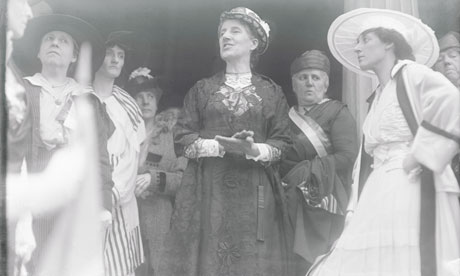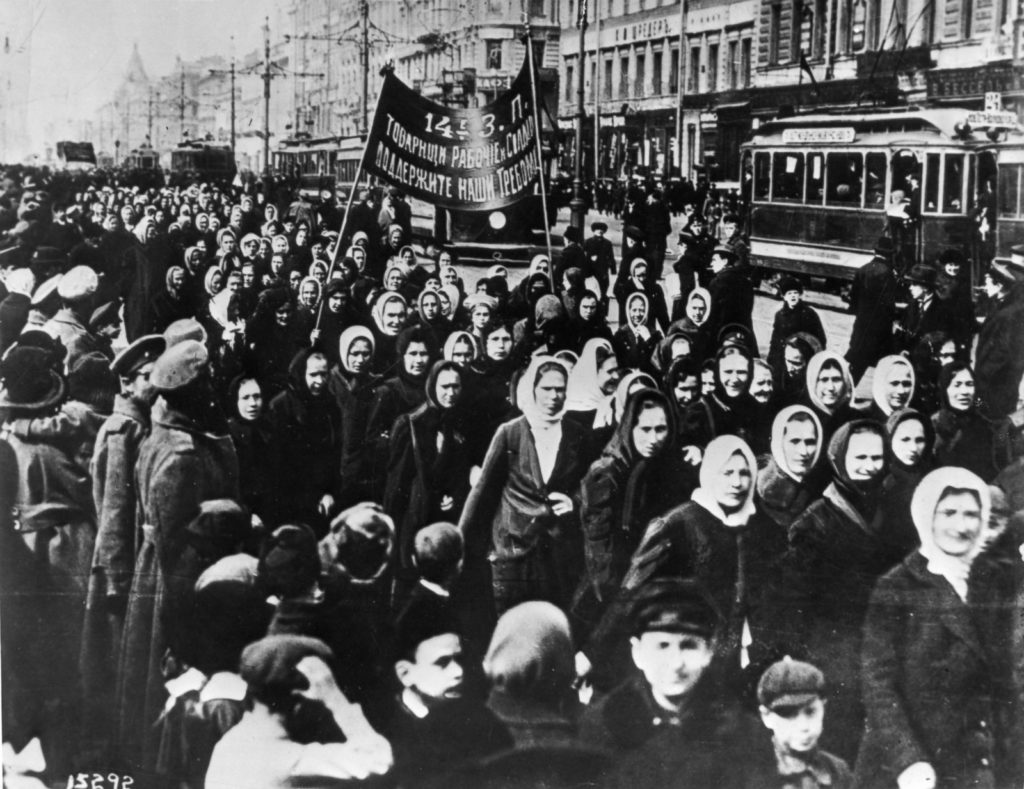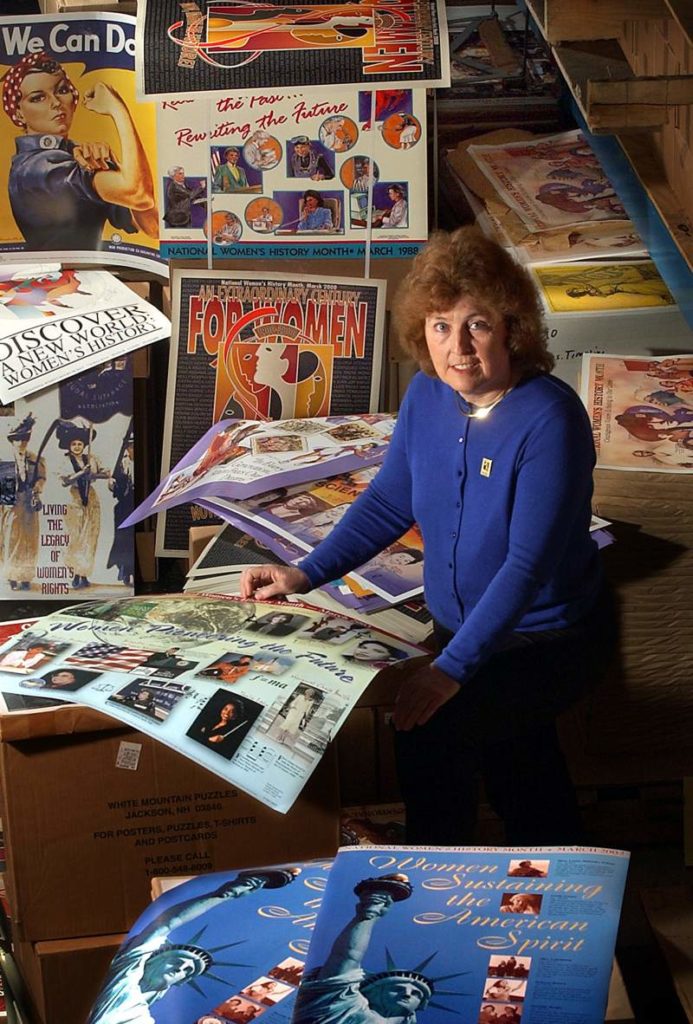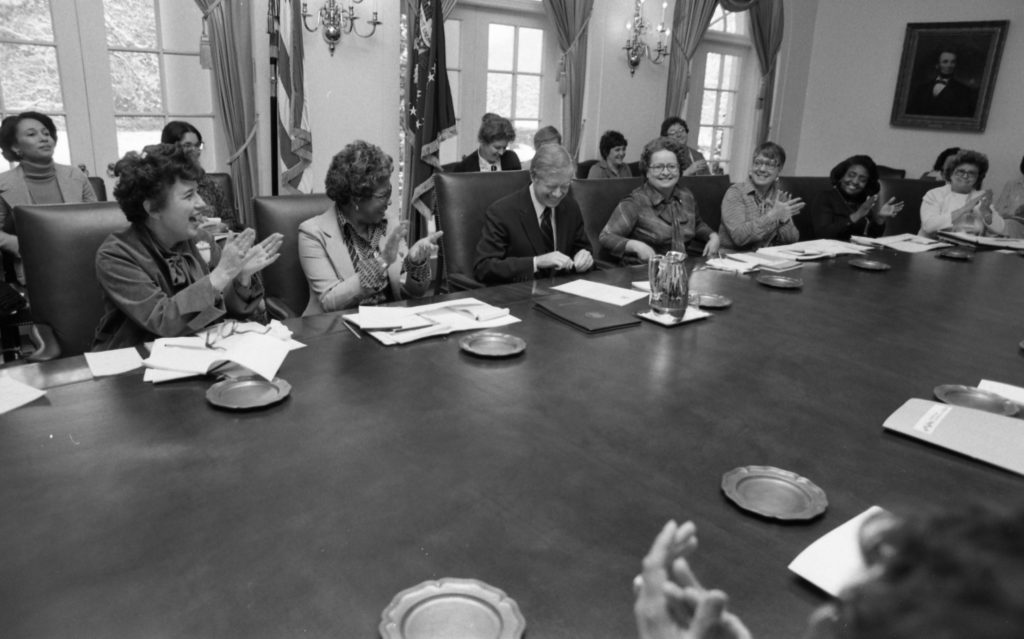A HISTORY OF WOMEN’S HISTORY MONTH

Women’s Day Banner, C. 1975. Courtesy of History.com
Women have been making history in our country since long before the founding of what we now know as the United States of America. However, their contributions were often looked over or relegated to the footnotes of history due to patriarchal norms in society. During the early 20th century, at the height of the women’s rights movement around the world, National Women’s Day was first celebrated in New York on February 28th, 1909. This celebration was organized by The Socialist Party of America. This was significant because the Socialist Party and the Women’s Rights movement often clashed over each other’s goals. They called for the day to be celebrated on the last Sunday in February so working women could participate. The event featured speakers such as labor organizer Leonora O’Reilly and Charlotte Perkins Gilman, author of The Yellow Wallpaper, an early example of American feminist literature.[1]

Activist Charlotte Perkins Gilman addressing a crowd, c. 1916. Courtesy of Wikimedia Commons
It wasn’t long until the concept of a Women’s Day caught on in Europe. On March 19, 1911, the first International Women’s Day was held. Worldwide the celebrations drew over 1 million people to rallies and marches. Even though social movements ground to a halt when World War I broke out, women continued to march and protest on International Women’s Day. One such demonstration happened in Russia on March 8, 1917. Led by Alexandra Kollontai, it ignited a chain of events that ultimately led to the abdication of Czar Nicholas II and the Russian Revolution. Shortly after the abdication, Russia became the first major world power to grant women the right to vote. Vladimir Lenin went on to declare Woman’s Day a Soviet national holiday later that same year. The communist governments of Spain and China soon followed. It would be until the 1970s before non-socialist countries began to celebrate International Women’s Day.[2] The United Nations recognized March 8 as International Women’s Day in 1975, which was recognized as International Women’s Year.[3]

International Women’s Day demonstration in St. Petersburg, Russia in 1917. Courtesy of Wikimedia Commons
In the rest of the non-socialist world, women’s history was not covered in schools, nor was it a part of the general public’s understanding. This may have to do with the fact that Women’s Day was so closely related to socialist and communist movements. This all began to change in 1978 when the Education Task Force of the Sonoma County Commission on the Status of Women in California expanded on Women’s Day and created Women’s History Week. The first one was celebrated the week of March 8th, 1978. Over a hundred women did presentations in classrooms around the country and the annual Real Woman Essay Contest was first held. The week ended with a parade and program in Santa Rosa, California. The following year, Molly Murphy MacGregor, a founding member of Women’s History Week in California, attended The Women’s History Institute being held at Sarah Lawrence College. After hearing about the success in California, the attendees banded together to ensure a National Women’s History Week.[4]

Molly MacGregor, co-founder of the Women’s History Project, 2013. Courtesy of Press Democrat
In 1980 several women’s groups, led by the National Women’s History Project, teamed up with historians and lobbied the federal government for official recognition. In February, President Jimmy Carter issued the Presidential Proclamation recognizing the week of March 8th, National Women’s History Week. In his proclamation, President Carter remarked:
“From the first settlers who came to our shores, from the first American Indian families who befriended them, men and women have worked together to build this nation. Too often the women were unsung and sometimes their contributions were unnoticed. But the achievements, leadership, courage, strength, and love of the women who built America was as vital as that of the men whose names we know so well.”
This did not create a formal National Women’s History Week, and subsequent years would see Presidential Proclamations honoring what Jimmy Carter started.[5] In 1981 Representative Barbara Mikulski, a Democrat, and Senator Orrin Hatch, a Republican, co-sponsored a Congressional Resolution For National Women’s History Week. This bipartisan bill demonstrated just how widespread support for national recognition had become. As support began to coalesce around the country, state departments of education began implementing Women’s History Week celebrations into their curriculum. In just a few years, thousands of schools were celebrating National Women’s History Week with the full support of school boards as well as local and federal politicians.[6]

President Jimmy Carter with prominent women’s groups in the Cabinet Room, immediately after signing the week into existence. Courtesy of Jimmy Carter Presidential Library and Museum / NARA
In 1986, fourteen states had made March National Women’s History Month a holiday. This momentum was used to lobby Congress into making the entire month of March into a celebration of women’s history. In 1987, this was made a reality and a special Presidential Proclamation is made every March honoring the achievements of American women.[7] Every year has a unique theme associated with the celebration and various women who contributed to the topic are celebrated. 2020’s theme is “Valiant Women of the Vote” to honor the 100th anniversary of women’s suffrage. The honorees this year are:
- Maria Teresa Kumar – CEO, Voto Latino
- Eleanor Holmes Norton – Civil Rights Leader, Congressperson, Lawyer and Organizer
- Terry Ao Minnis – Senior Director of the Census and Voting Programs, Asian Americans Advancing Justice
- Edith Mayo – Suffrage Historian, Women’s History Movement Activist
- Lucy Burns (1879-1966) – American Woman Suffrage Activist
- Carrie Chapman Catt (1859-1947) – American Woman Suffrage Activist
- Wilhelmina Kekelaokalaninui Widemann Dowsett (1861-1929) – Suffragist and Founder of the National Women’s Equal Suffrage Association of Hawai’i
- Ana Roqué de Duprey (1853-1933) – Suffragist and Co-founder of the University of Puerto Rico
- Elizabeth Piper Ensley (1847-1919) – Educator and African-American Suffragist
- Marie Foster (1917-2003) – Civil Rights Leader
- Mabel Ping-Hua Lee (1896-1966) – Suffragist, member of the Women’s Political Equality League
- Virginia Louisa Minor (1824-1894) – American Women Suffrage Activist
- Anna Howard Shaw (1847-1919) – American Woman Suffrage Activist[8]
By: Cody Robinson, Museum Specialist
References:
[1] Sarah Pruitt, “The Surprising History of International Women’s Day,” last updated August 22, 2018, https://www.history.com/news/the-surprising-history-of-international-womens-day.
[2] Pruitt, “The Surprising History,” last updated August 22, 2018.
[3] History.com Editors, “Women’s History Month 2020,” last updated February 28, 2020, https://www.history.com/topics/holidays/womens-history-month.
[4] Molly Murphy MacGregor, “Why March is National Women’s History Month,” accessed March 17, 2020, https://nationalwomenshistoryalliance.org/womens-history-month/womens-history-month-history/.
[5] “Women’s History Month,” National Women’s History Museum, accessed March 17, 2020, https://www.womenshistory.org/womens-history/womens-history-month.
[6] MacGregor, “Why March is,” accessed March 17, 2020.
[7] Ibid.
[8] “2020 Honorees,” National Women’s History Alliance, accessed March 17, 2020, https://nationalwomenshistoryalliance.org/2020-honorees/.
